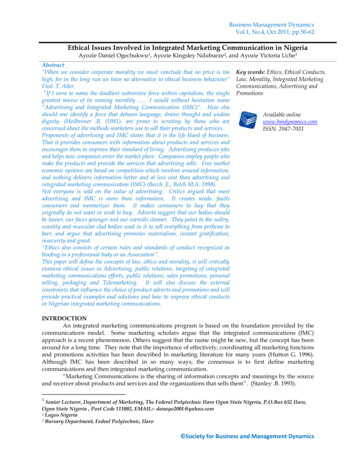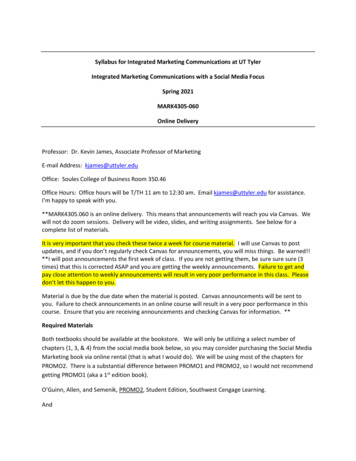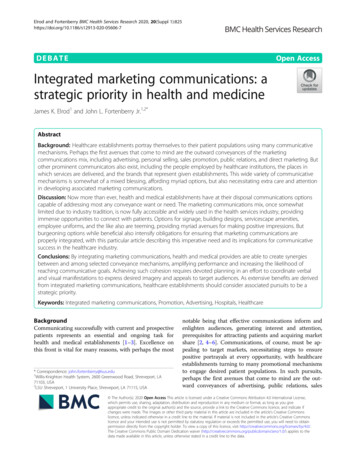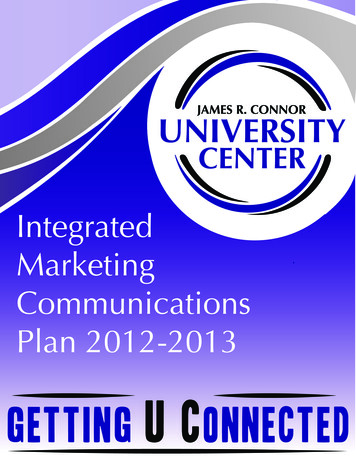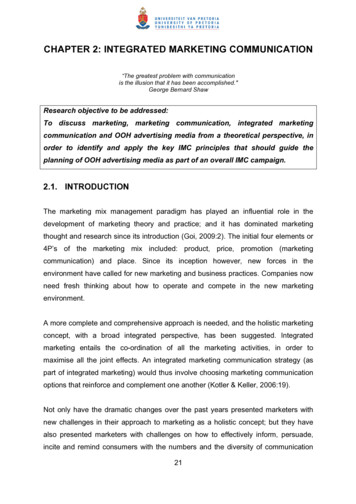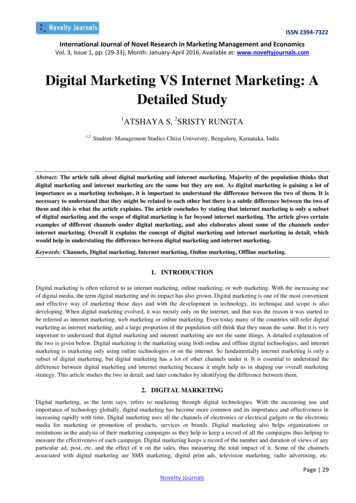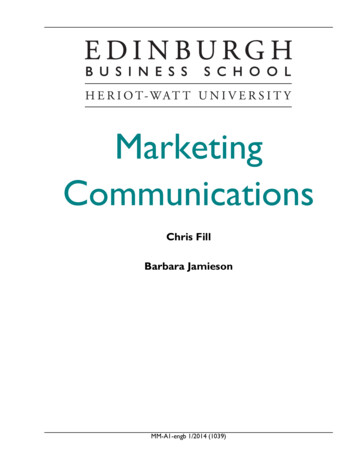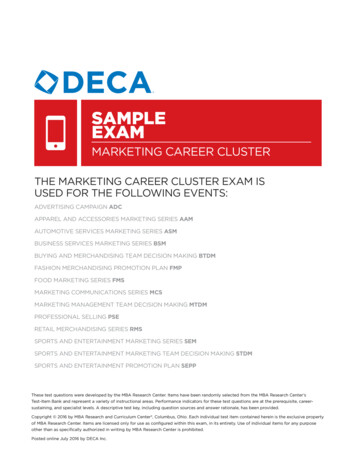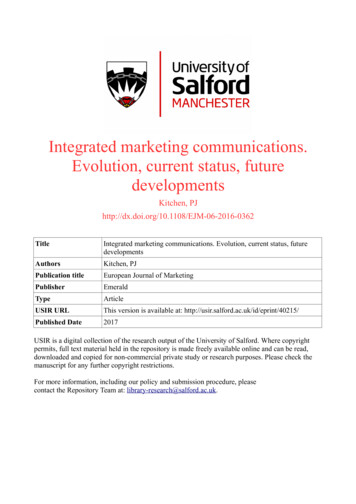
Transcription
Integrated marketing communications.Evolution, current status, futuredevelopmentsKitchen, ntegrated marketing communications. Evolution, current status, futuredevelopmentsAuthorsKitchen, PJPublication titleEuropean Journal of MarketingPublisherEmeraldTypeArticleUSIR URLThis version is available at: d Date2017USIR is a digital collection of the research output of the University of Salford. Where copyrightpermits, full text material held in the repository is made freely available online and can be read,downloaded and copied for non-commercial private study or research purposes. Please check themanuscript for any further copyright restrictions.For more information, including our policy and submission procedure, pleasecontact the Repository Team at: library-research@salford.ac.uk.
European Journal of MarketinganperoEuIntegrated Marketing Communications - Current Status,Future DevelopmentsJournal:Manuscript IDManuscript Type:European Journal of Jo
Page 1 of 10Integrated Marketing CommunicationsEvolution, Current Status, Future DevelopmentsanperoEuIntroductionSince the first book on integrated marketing communications (Schultz, Tannenbaum, & Lauterborn 1993), mediasand technologies have expanded and accelerated while markets have further fragmented (Kitchen, 2010; Kitchen&Uzunoglu, 2015; Schultz, Patti & Kitchen, 2013). Measuring return on investment has become morestraightforward on-line via mobile, yet more complex as many more channels (medias) have proliferated.Consumers are now more streetwise, savvy, and sophisticated. At the same markets have splintered into smallersegments and niches, audiences have become more difficult to reach or access, influence and persuade. Hence, inthe marketing communications world a multiplicity of medias communicate messages which often are entirelyirrelevant to viewers, listeners and readers creating not only environmental noise but also market nuisance.Despite accelerated communications modalities, it is only a few years since the world experienced a majoreconomic crisis. That alone severely dented consumer confidence, and the aftershocks and aftermaths of thatcrisis will continue to be felt over many years (Kitchen, 2013). Yet, already in 2016, at least in the UK banking andmortgage sectors the same old pattern of 100% mortgages is already being communicated or promoted foradmittedly a smaller proportion of apparently high income consumers (Financial Stability Report, 2015). Thus, thecrises of the past will be revisited in the future and insofar as marketing communications is concerned it is onceagain – business as usual.urJoLeaving aside environmental turbulence, this special issue seeks to present the latest research from academicparticipants in the field of marketing and brand communication and measurement concerning integratedmarketing communications (IMC). It is likely that the thoughts and views offered in this special issue will help tomold and shape the subject as we move further 2020.lonaIMC has become one the most influential marketing management frameworks over the last two decades. It is nowthe overarching theme of every marketing communications text, it is the title for chapters in marketingmanagement texts, and it is the oft repeated theme of professional books and articles presented at practitionerand academic conferences. Moreover, academic journal special issues and editorials have been presented byJournal of Advertising, Journal of Advertising Research, Journal of Marketing Communications, the InternationalJournal of Advertising and in other academic journals and there have been several hundred papers in themarketing and communications practitioner press and calls for papers for special issues continues. Majormarketing associations now include courses on IMC as a norm. A great deal of interest in IMC has been manifestby American Productivity and Quality Council (APQC), the American Marketing Association (AMA) and advertisingassociation such as the Institute of Advertising Practitioner (IPA) and their equivalents in other countries. Further,the focus on measuring marketing investments and activities and developing integrated approaches to marketingwas one of the Marketing Science Institute priorities from 2014 to 2016. That emphasis continues as from 2016 to2018 the priority has been adjusted to: ‘delivering integrated, real-time, relevant experiences in context’ (MSI,2016), a point reinforced in a recent paper by Tafesse & Kitchen, 2015 that ‘the first, and perhaps most important,research priority is measurement’ and supported earlier by Ray Taylor (2010). Undergirding and overarching theacademic crescendo is the apparent adoption and usage of IMC by companies and agencies of all types. But, is IMCmore about vocalization, volume or does it concern actual usage? How this takes place is among the subjectsaddressed 48495051525354555657585960European Journal of MarketingChallengesChallenges facing todays marketing and brand managers concerning ongoing distinction and concomitant interfacebetween traditional and usually offline sales, marketing and communications and the new, online interactive sales,1
European Journal of Marketingmarketing and communication, and combinations between the old and the new. Brand marketing communicationactivities are focused upon customers and prospects with the need to measure or show marketplace results.In the first special issue on IMC published in the Journal of Marketing Communications (1998), Don Schultz andhis wife Heidi, spoke of transitioning from old to new ways of communicating, based upon the needs associatedstwith the needs of the 21 century. How does a firm or brand move from their current location to where theystneed to be in the dynamic global marketplace of the 21 century? They argued that the old 4Ps (product, price,promotion, place) approach was essentially outbound, linear, and driven by a supply-side orientation (Schultz andSchultz, 1998). The reality is of course, that markets are not, and perhaps never have been product, production, oreven marketing–driven (Kitchen, 2010). Today - perhaps more than ever before, markets are driven by customers,consumers, and prospects. Demand-side factors are just as important as supply-side considerations. And, one day– if technological facilitators permit - all economies pace businesses will be customer-dominated and customerdriven. We are not there yet, and may not be for some time, but it seems reasonable to claim that a business thatunderstands its customers and communicate to and with them, with the recognition that business is demanddriven should be able to access and capitalize upon a continuous stream of ongoing information that leads tocompetitive advantage.anperoEuHence, customer insight and integrated brand communication strategy are likely crucial keys to competing in andwinning the marketing game, a game vociferously fought in every country and every market.JoSo, it would seem on the one hand that the road to integration of messages is complete, as the ideal of one-voice,one-sight, one-sound proclaimed by Don Schultz and his colleagues at Northwestern – and others since then - hasbecome the standard or norm across the world. Thus, what commenced as a single track, in the practitioner worldof the late 1980’s, with an academic awakening and contributions in the 1990’s and 2000’s – underpinned bymarketplace changes - has become a superhighway for companies, commentators, and academic researchers.urHowever, though the road toward IMC practice as found in earlier texts and seen as the integration of promotionalmix variables (or the the ‘one voice’ phenomenon) reached its zenith, the journey toward integration from aconsumer or corporate perspective has scarcely begun. Thus, what Don Schultz and I (2000) regarded as a fourstage process, for the majority of companies, has – to all intents and purposes - stalled at its very beginning. Yes,we have ‘message integration’ but not necessarily ‘consumer integration’. Most companies carry out poor,ineffectual market research. There is an insufficiency of real understanding of markets, marketplaces, ormarketspaces. There is a concomitant lack of investment in database and data systems to gather information formcustomers and consumers on an ongoing basis. Thus, most messages are still outbound and linear, with the addedvirtue of looking or sounding the same via all media. Integrated brand marketing, where one measures behaviouraloutcomes in response to marketing communication, remains a far-fetched dream for most companies. IMC, whileit has achieved its goal in one direction i.e. message integration, has not reached its subsequent purpose as astrategic business process (Schultz and Kitchen, 2010) in terms of strategic integration or for that matterorganizational integration. It is, however, moving in these directions as evidenced in these pages.arfMlonaFurther, there are techniques, processes and workable techniques for after-the-event evaluation of integratedmarketing communications. But, as in all searches for a holy grail, almost none work with immediacy, or duringcampaign implementation. However, a more realistic picture of IMC may be gradually emerging from themaelstrom of debate, conceptualisations and currently available empirical evidence. For example, it can be claimedthat IMC adoption, irrespective of theory, is both situation-specific and context-dependent. Thus, while it is awidely accepted model and paradigm, its use or implementation depends on what the company wishes to dowithin its own budgetary constraints or what senior managers proscribe, particularly in terms of investment in dataanalytics, customer interfaces and communication 4748495051525354555657585960Page 2 of 10There still are difficult and problematic issues. IMC, in terms of its major tenets, design, contribution, and benefits,has gained academic and practitioner acceptance throughout the world. One can already make out the bones ofwhat could be termed a ‘central theory’, which most IMC researchers and practitioners would accept. Around theedges (i.e. of PR, of turf battles, of a stages theory of IMC etc), there is and will be always be healthy disagreement,conjecture, and criticism. IMC has already proved to be remarkably robust; it is no passing phase or passing fad2
Page 3 of 10(Kitchen, 2004; Kitchen, 2010). However, the time has come for more evidence to be presented from companiesand for more sophisticated questions to be asked and answered. Only then, will IMC’s weak theoretical foundationsbe strengthened. Current barriers are capable of being understood, corrected, and overcome. And, despiteacademic quibbling - the crucible of practice, where IMC was born and grown - is where the cutting edge of IMCcontinues to be manifest and undergoes change.anperoEuThis special issue offers papers which debate the meaningfulness of, and challenges pertaining to IntegratedstMarketing Communications (IMC) in the 21 century and as readers will observe, papers are provocative, multidisciplinary and eclectic . All, however, assist in unraveling and understanding IMC.Unusually, in an introduction, I would like to thank all those who submitted papers. I also thank a veritableregiment of 80 or so great reviewers, all of whom were invited or selected because of their interest in,involvement with, and publications relating to IMC. I have to say, however, we were inundated with papers fromall over the world.In the original call for contributions were sought that would offer innovative insights based on rigorous andthoughtful conceptualization, deep literature review, empirical evidence and/or case studies surrounding, but notnecessarily limited to the following research areas: lo na ur How and in what ways is IMC taught around the world? How should it be taught and what shouldstudents be expected to learn? How does technological advancement impact a) IMC; and b) how it istaught?Evidence of IMC adoption and usage in companiesInteractions between IMC and ICC (integrated corporate communications)IMC and social mediaEvolution of IMC, its current status and relevanceConnections between IMC, brands and branding in an interconnected and interactivemarketplace/space.Measurement – how and in what ways are IMC approaches accountable now, and how may thesebecome moreAs IMC was developed in the West, how and in what ways is IMC operationalized in new or emergentmarkets. Is there any evidence of leapfrogging previous stages of development?JoThe Harvest of PapersfMIn the sub headings below, these do not necessarily represent the total contribution or focus of the papers, thougha major thrust of a paper may fall into a specific domain. Many of the papers overlap and interfuse betweendifferent related topics. However, all add to the topic under consideration – integrated marketingcommunications.arEDUCATIONkeThe paper by Kerr & Kelly addresses the issues of IMC education in the context of digital disruption. It adopts theDelphi technique in recruiting IMC thought leaders and educators from major economic areas in the world. Thepaper indicates that IMC education is widespread, and that the term ‘IMC’ or ‘integrated marketingcommunications’ has become common parlance, and is here to stay. It is noted that while few object to the term‘IMC’, its meaning and implementation varies significantly across geographic areas, countries, and companies.Three major recommendations include the requirement to: a) position IMC as the integrator and digital as thefacilitator. This requires, however, leads to the recommendation b) that more data-minded faculty are needed (i.e.faculty with digital and mathematical skills). c) recognizance of a nascent need for an IMC academic association,perhaps serving to help drive the subject forward in a coordinated 5051525354555657585960European Journal of MarketingThe theme of education and learning from an organizational context is also addressed by Luxton, Reid, & Mavondowhose paper addresses organizational antecedents influencing the adoption and usage of IMC capabilities. As is3
European Journal of Marketingmade clear, organizational or managerial learning is dependent upon a firms marketing and brand orientation.Such orientations may lead to strategic consistency, program implementation and adaptation and eventuallysuperior brand performance. Thus, adopting IMC in one form or another, without first addressing these issueswould seem to be a recipe for one voice integration, which is the easiest and simplest way to adopt IMC (see forexample, Schultz et al, 1993). In addition, Luxton et al add brand size. While for large brands, IMC is nowconsidered to be a critical element of a brand equity strategy, small firms often lack resources and thus their brandbuilding activities may be poorer in terms of investment, or innovative by reason of resource constraint. Thefindings show that brand orientation (not necessarily market oriention) is a critical antecedent - moreover thebrand - however defined is seen as an organizational asset underpinned by ongoing analysis of the needs of servedmarkets i.e. this includes customer and competitor information. Such information is fundamentally necessary tothe development and implementation of consistent integrated marketing communication. Thus brand orientationdepends on market dynamics, which if understood correctly, lead to integrated communications, which leads toimproved overall brand performance. It is interesting that the brand has become the asset, while earlier IMCauthors claimed that customers or consumers were the asset (see Schultz & Schultz, 1998). I suspect both brandsand customer dynamics are inextricably interrelated, with IMC acting as the intervening variable between. nb, thetheme of organizational antecedents is also addressed in a later paper by Foroudi et al (IMC antecedents and theconsequences of planned brand identity in HE).anperoEuA paper by Finne and Gronroos concerns moving from a focus upon the sender, the organization or source, to afocus upon the customers integration or sense-making of communications which lays a conceptual foundation formovement toward outside-in oriented customer-integrated marketing communication. Yet, as is made clear in thepaper, this movement was prefigured by earlier writers commenting upon an outside-in approach to IMC (seeKitchen & Schultz, 2004; Kitchen, Kim & Schultz, 2010), with Don Schultz the first to argue for this approach(Schultz, 1996), which of necessity corresponds more appropriately with marketing perse. The paper argues for aradical re-education of marketing practitioners and academics. The dominant mindset relates more to brands,organisations and marketing personnel. The new mindset refers much more about how to relate to customers andto their ecosystems. The aim is to lead to customer engagement and involvement in terms of communications-inuse. However, this does not necessarily simplify communications, but a greater understanding of customers maylead to efficiency savings, greater relevance, and perhaps even a reduction in the barrage of unwanted anduninteresting bombardment of [marketing] communications to increasingly resistant and annoyed receivers. Inother words, to direct attention to customer activity and logic and the ecosystem(s) that influence their behaviour.Naturally, such change means mental models in marketers needs to change – perhaps the most difficult of alleducational challenges.fMlonaurJoI would greatly encourage proposals that seek to draw organisations closer to their customers, consumers, targetmarkets and stakeholders. I would welcome the testing of the conceptualisations by Finne and Gronroos, and lookforward to the empirical evidence.arA later paper by Mortimer & Laurie also draws attention to the need for IMC education by company and brandmanagers and also the need for training of agency executives in a national context – in this case the UK.keOrganisational and Brand PerformanceLuxton et al have already touched upon the topic of brand performance and lucidly described its antecedentsincluding IMC. Ots & Nyilasy, via an ethnographic case study at a leading Swedish retailer, picks up on the oftrepeated theme of the need for empirical evidence between what IMC theories may prescribe versus whatpractitioners actually do in practice. In other words how do practitioners actually behave? What tools ortechnologies do they use? Which rules or procedures do they follow? What cultural templates, often tacit to users,do they draw upon? And, also , what personal understanding or teleoaffective structures do they draw upon? Theoutcomes show - as might be anticipated to some degree, that planning by analysts, brand managers andcampaign planners comes first, which is underpinned by market and brand data. Developed plans are thenapproved within their selected retail organisation. This leads to positioning attributes which are then presented,discussed, and tested by a range of customers and stakeholders. This is followed by material set-ups that serve 25354555657585960Page 4 of 104
Page 5 of 10enablers and barriers to integration. At no point in the process does IMC-strategizing begin with a blank canvas. Infact, if we commence with consumer data-driven understanding the canvas perse will never be blank. Data drivenunderstanding in this case example, is followed by the other elements of the model described in the plan (see fivequestions above) and operationalized during a two year process.anperoEuThe conclusions make clear that a complete and useful theory of IMC needs to contain theoretical understanding ofwhat happens in terms of its practical use. The ‘lived experience’ of IMC needs to be incorporated into theliterature. This has been argued for for many years. I agree with the authors that it is imperative that the world oftheory and the world of practice needs to be brought into juxtaposition. For, as is also made plain in this paper,there is no shortcut to drawing upon organizational experience or practice of IMC planning and implementation.Nostrums or prescriptions taken from the literature are insufficient.The challenge of implementation is also taken up by Mortimer & Laurie and follows from a series of studies of IMCpractice relative to UK organisations. The paper adopts a critical realism approach. Despite many studies in the UKpreviously, the paper (in my view, disappointingly) finds that UK clients (i.e. the ‘driving force’ behind IMCimplementation) are facing barriers to those facing other countries a decade or so ago. Summarised these include: Difficulty in understanding IMCThe risks of changeMarketing departments lacking control or influence over other parts of the organization, frequentlymarketing may not be or is not represented at board levelAgencies may not have a clear role of IMCJoThe third point seems to be excusable as agencies always act in accordance with client instructions. The first threebullet points seem to relate to the relative poor status of marketing in the UK, amid a general unwillingness toinvest in new ideas, processes, and technologies – which sum to a marked tendency of organisations or theirmanagers to draw closer to customers, or put another way, to allow customers any real access to influencemarketing processes.naurThe earlier point of the need for education is reinforced here. However, context – in this case – nationalexpectations, norms and behaviours seem to result in barriers to continuing innovation, including the adoption andusage of IMC. But, if the world of business continues to move in the direction of greater customer involvement inmarketing, then this does not spell a bright future for hidebound UK companies.fMloBrand IdentityThe theme of IMC antecedents and planned brand identity is analysed by Foroudi et al relative to two Londonbased universities. Admittedly, as universities are drawn further into marketization, the need to communicatebrand positioning and benefits to different audiences is mandated. The paper shows that among the driving forcesfor IMC, identity and strategy must also be taken into consideration. Support is given for the oft-repeated assertionthat consumer attitudes may be enhanced by following a strategy and consistently integrating messages acrosscontrolled communication. In addition, the relationship between brand strategy and uncontrolled communicationhas not yet been proved, albeit in this particular context. Understanding of these extraneous communicationsneeds to be enhanced. In either form of communication, relationships between brand and consumer needs to beunderstood and enhanced. The outcome is that IMC programmes based on identifiable parameters shouldunderpin brand loyalty.tinkearI would like to see further empirical studies of what HE marketing communication professionals do in IMC termseither from a marketing or corporate communication perspective. Studies are few and far between and theburgeoning growth of higher education in the UK and its evident success with UK and overseas students make this arich and fertile field for IMC studies in the 1525354555657585960European Journal of MarketingNetworked brand identity and multi-stakeholder perspective in a retailer context is the focus of a conceptual paperby Orazi et al. Both this paper and the previous one, extend IMC more into the boundaries of corporate5
European Journal of Marketingcommunication, an area which fits more coherently with the notion of integration perse. Admittedly, there arecrossovers and interconnections with marketing and the need to differentiate between the two communicationtypologies is mandated. Neither controls the other, and while it would seem that marketing communicationsgenerates by far the lions’ share of budget, the corporate communications domain is becoming more important ascorporate brands also need to be communicated, perhaps more to stakeholders.anperoEuHowever, to return to Orazi et al - the entire network of a firms stakeholders are now – or have the capacity to be- involved in the creation and communication of brand identity. New digital media and technologies amend, adjustor alter traditional albeit integrated processes of communicating brand identity, with significant communicationsnow occurring with stakeholders external to a firm. Thus, traditional and more modern contact points must benavigated effectively in today’s marketplaces/spaces in developing, maintaining and building brand equity. Thislikely means, as recommended by the authors, that a host of activities (i.e. contact points) that define consumerand stakeholder brand perceptions may not always be instigated and managed by the IMC function. However, IMCspecialists could readily be seconded into other managerial functions such as human resources or corporatecommunications to orchestrate brand activities in aligning brand identity and image and subsequently brandequity. The need is manifest though, to undertake empirical research and to test the robust hypotheses developedhere.A second paper by Foroudi et al concerns corporate and brand identity and the need to integrate this into strategyand controlled and uncontrolled communications to inculculate trust, loyalty and commitment via integratedmarketing communications. However, one weakness is to differentiate between corporate brands and marketingbrands depending upon brand architecture. In some companies, the corporate brand and the brand marketing areone and the same. In other corporations, corporate brand communications may be minimal in terms of expenditurewhen compared to expenditures on individually known and well-loved brands. There the structure of corporate,SBU, product category and individual brand communication may need to be considered. As was said earlier, IMCmay well be and likely is both situation-specific and context-dependent. Put another way, a generalized approachto IMC must include industry, company, brand, context, and competitive circumstance. In each case (followinganalysis of brand architecture and market dynamics, the question of whether the company’s identity, strategy andpersonality do communicate an authentic message to a target audience. Further the audience can be customers,consumers, or stakeholders and the source and directionality of the communications needs to be clearly identified.As was indicated in a previous paper, in a world of increasing access to social media, both controlled anduncontrolled communications need to be assessed in terms of their impact upon brand identity and equity.lonaurJoA paper by Porcu et al, while focused mainly upon measurement, upon firm-wide IMC, looking at the subject froman organizational perspective and clarifies issues regarding the name and acronym, definition, and dimensions ofthe concept. Similar to the paper by Foroudi et al, it extends IMC from its initial location in marketingcommunications or promotion, and moves into the organizational marketing and corporate communication. Thusstakeholders, constituencies and publics also need to be considered and measurement forms developed.arfMNew Media & Changing Environmental CircumstancesWhile IMC is admittedly accepted as a sophisticated and efficient communications discipline, the marketingcommunication environment continues to present challenges, and always will. IMC does seem to offer, however,the flexibility to adjust and change as needed relative to changed circumstance. Turner’s paper addresses how IMCcan be utilized in the case of a major event sport sponsorship – the Asian Cup 2015 and particularly how businessand community leaders assisted in facilitating event communication in a multilingual region i.e. across 16 countries.In a sense, this can be likened to a multinational or global company integrating a major sponsorship across manycountries. In this case, the ambassadors assisted in writing and placement of advertising across the countries.Further, business, media groups, religious groups and community bodies presented an additional range of nuancedsubtleties which required nuanced address. Further, local and national communication via many communicationmedias and modalities had to be linked back or connected to the overall communication campaign. The role of theambassadors became crucial especially as they had to interact with, and respond to, various stakeholder groups.Traditional media (advertising, WOM, direct marketing and personal selling) were all used. However, new mediaand social media relative to different stakeholders was also needed (i.e. using their own language and 464748495051525354555657585960Page 6 of 106
Page 7 of 10associated cultural idiosyncracies). Turner states that - in effect, the ambassadors became quasi internalstakeholders.In the Close, Hempel, and Kang paper, touchpoints are again addressed, and IMC or here IBP (integrated brandpromotion) requires every touch point of value to be accessed and used. In conjunction with other papers, theauthors see a future where a brand focus is required with demonstrable synergies in digital and multi-modalcommunication. In this paper, the authors develop the notion that emails with embedded video content are m
the focus on measuring marketing investments and activities and developing integrated approaches to marketing was one of the Marketing Science Institute priorities from 2014 to 2016. That emphasis continues as from 2016 to 2018 the priority has been adjusted to: 'delivering integrated, real-time, relevant experiences in context' (MSI,
